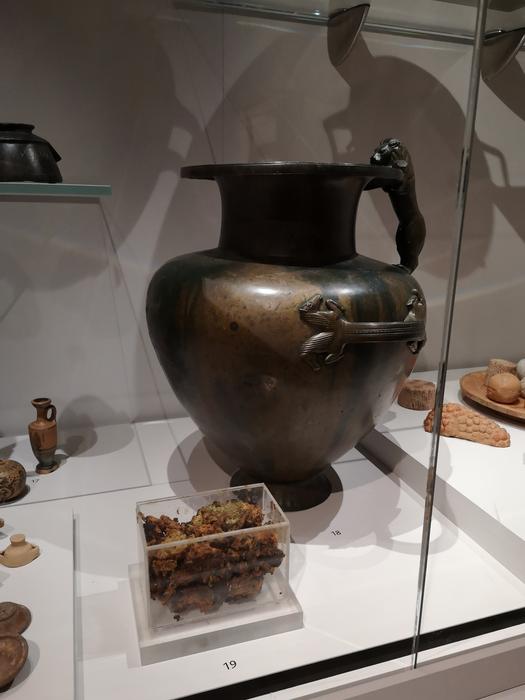In a groundbreaking revelation that bridges antiquity and modern science, a team of researchers has unveiled compelling evidence identifying a mysterious substance found inside ancient bronze jars as ancient honey. This remarkable finding emerges from a reanalysis of residues discovered in the mid-20th century within a shrine dating back to around 520 BCE, located in Paestum, Italy—an archaeological site renowned for its well-preserved Greek temples. The new study challenges decades of prior assumptions and offers fresh insight into the chemical life of ancient organic materials, revolutionizing our understanding of the preservation of bee products across millennia.
The original discovery took place in 1954 when archaeologists unearthed several bronze vessels containing a sticky residue inside an underground Greek shrine near Paestum, approximately an hour and a half’s drive from Pompeii. At first glance, these sticky remnants were believed to be honey, possibly offered as honeycombs in religious ceremonies or funerary practices, reflecting honey’s esteemed status in ancient cultures. However, over the subsequent thirty years, analytical efforts by multiple research teams repeatedly failed to validate the presence of honey. These earlier investigations suggested the residue comprised a mixture of fats—either animal or vegetable in origin—linked with contamination by pollen and insect fragments, casting doubt on the initial hypothesis.
Recent technological advancements in analytical chemistry reignited scientific curiosity about this enigmatic substance. Leveraging a suite of state-of-the-art techniques, including molecular fingerprinting and protein analysis, researchers led by Luciana da Costa Carvalho and James McCullagh revisited the samples now housed at the Ashmolean Museum. From these detailed investigations, they observed molecular signatures remarkably akin to those found in contemporary honey and beeswax. Such chemical congruence implies the substance had undergone extensive transformations yet managed to retain crucial compositional traits over nearly 2,500 years.
A pivotal element of the research involved distinguishing between degraded beeswax and other possibilities, such as fats and oils, which can produce overlapping chemical profiles in aged samples. The team demonstrated that the residue’s acidity exceeded what would be expected from simple heat-induced degradation of beeswax, suggesting the inclusion of more complex and diverse components—likely honey and possibly other bee-derived materials. Notably, chemical scans of areas where the residue contacted the bronze revealed degraded sugars bonded with copper ions, a novel discovery pointing to biochemical interactions between organic matter and metal containers over extended periods.
Further supporting the honey hypothesis was the detection of elevated hexose sugar concentrations within the residue. Hexoses, including glucose and fructose, are primary constituents of honey’s sugary matrix but are noticeably absent or minimal in beeswax. Even more compelling was the identification of royal jelly proteins—substances secreted exclusively by the western honeybee (Apis mellifera)—within the samples. These proteins’ presence indicates not merely a passive accumulation of residues but an intricate preservation of complex biomolecules typically associated with living bee products.
The ramifications of these findings extend beyond the mere identification of ancient honey. They open new avenues for exploring how organic compounds survive in archaeological contexts and how metal artifacts influence the chemical evolution of biological substances over time. The researchers emphasize that ancient residues are not inert leftovers but dynamic, multi-component chemical ecosystems shaped by microbial activity, environmental interactions, and burial conditions. Such complexity challenges simplistic notions of archaeological residues as static remnants and underscores the potential for future interdisciplinary studies combining chemistry, archaeology, and microbiology.
This study also enhances our comprehension of honey’s cultural and symbolic significance in ancient societies. Honey was frequently revered as a symbol of immortality and divinity across the Mediterranean world. Its use in shrines and as funerary offerings underscores how ancient peoples esteemed honey not only as food but also as a sacred substance capable of transcending mortality. Discovering authentic honey residues in situ confirms the historical narratives and enriches the archaeological record with concrete chemical evidence.
Methodologically, the work relied on precise, high-resolution mass spectrometry, chromatographic separation, and proteomic analysis to dissect the residue’s components. Such advanced techniques allow differentiation between chemically similar substances, tracking subtle molecular degradation pathways, and verifying biomolecular origins even after extensive aging. This synergy of modern analytical tools exemplifies how cutting-edge chemistry can unlock secrets long concealed within ancient artifacts.
While the researchers confidently associate the sticky residue predominantly with honey and its derivatives, they caution against excluding the coexistence of other bee products, such as propolis or royal jelly, which might also have contributed to the chemical complexity observed. This nuanced perspective acknowledges the multifaceted nature of ancient beekeeping and apicultural practices, which likely produced a variety of biologically active substances.
Beyond archaeology, understanding the transformations experienced by honey and bee products over millennia has broader implications. Insights gleaned about natural preservation and microbial interactions can inform conservation science, biomimetic material design, and even the development of novel antimicrobial compounds inspired by ancient biomolecules. Thus, the study exemplifies how historical investigations can stimulate contemporary scientific innovation.
In summary, this landmark research published in the Journal of the American Chemical Society not only substantiates the presence of ancient honey within bronze containers dating back to the early 6th century BCE but also propels the scientific discourse about organic matter preservation, metal-organic chemical interactions, and the cultural importance of bee products. It stands as a testament to the power of interdisciplinary collaboration and the ever-expanding frontiers of chemical archaeology, promising to inspire future explorations into the materials that shaped human civilization.
Subject of Research: Identification and chemical characterization of ancient honey residues in bronze jars from a 6th-century BCE Paestum shrine
Article Title: A Symbol of Immortality: Evidence of Honey in Bronze Jars Found in a Paestum Shrine Dating to 530-510 BCE
News Publication Date: 30-Jul-2025
Web References:
http://pubs.acs.org/doi/abs/10.1021/jacs.5c04888
References:
Adapted from the Journal of the American Chemical Society 2025, DOI: 10.1021/jacs.5c04888
Image Credits:
Adapted from the Journal of the American Chemical Society 2025, DOI: 10.1021/jacs.5c04888
Keywords:
Chemistry, Archaeology, Honey, Ancient residues, Biomolecular preservation, Bee products




